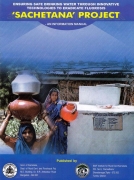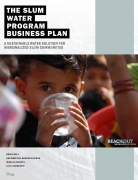/sub-categories/news-and-articles
News and Articles
Ensuring safe drinking water through innovative technologies to eradicate fluorosis - Sachetana Project - Information manual by BIRDK and Govt of Karnataka
Posted on 05 May, 2010 05:31 PM This manual produced by BIRD-K and DRDPR (GoK) provides the details of the Sachetana project that aims to provide safe drinking water to fluorosis affected populations through the adoption of innovative technologies for rainwater harvesting and groundwater recharge.
This manual produced by BIRD-K and DRDPR (GoK) provides the details of the Sachetana project that aims to provide safe drinking water to fluorosis affected populations through the adoption of innovative technologies for rainwater harvesting and groundwater recharge.
The project is being implemented through the Gram Panchayats of 60 villages from 4 taluks among three districts of Karnataka state over a period of five years (2006-11).
The objectives of the project include:
- Provision of safe drinking water through innovative rain harvesting structures
- Recharge of groundwater through excavation of percolation ponds
- Recharge of existing bore wells and direct recharge of aquifers
- Awareness generation activities to promote sustainable management and management of water resources and water harvesting structures.
The slum water programme business plan: A sustainable water solution for marginalized slum communities - A document by ROWS
Posted on 03 May, 2010 10:28 PM This document by Reach Out Water Solutions (ROWS) highlights the daily reality of people living in the slums of Mumbai and the inadequate water supply available to the 10 million slum residents to meet their daily requirements.
This document by Reach Out Water Solutions (ROWS) highlights the daily reality of people living in the slums of Mumbai and the inadequate water supply available to the 10 million slum residents to meet their daily requirements.
It presents a business plan, namely the Slum Water Programme (SWP) that proposes a comprehensive, community driven, decentralised programme to meet the water needs of the slum community.
The programme proposes to do this in three ways:
- Firstly, by dealing with the problem of inadequate supply of water to the slum residents by the municipality, through increasing the availability of water
- By providing improved quality of water through utilising water purification techniques
- Improving access to water by making it available at the doorstep
Urban Population and WatSan: A brief status report by WaterAid (2009)
Posted on 03 May, 2010 04:44 PMThis document by WaterAid India, India highlights the poor water and sanitation situation in the urban slums in India, in the context of rapid urbanisation and the increase in the number of slums and slum dwellers in the cities.
An article on Ganga in Ground Report India by Dr. Amarnath Giri
Posted on 03 May, 2010 11:27 AM
Credits to: Ground Report India April-2010-Edition
Hindus have always believed that water from India's Ganges River has extraordinary powers. The Indian emperor Akbar called it the "water of immortality" and always traveled with a supply. The British East India Co. used only Ganges water on its ships during the three-month journey back to England, because it stayed "sweet and fresh."
Indians have always claimed it prevents diseases, but are the claims wives' tales or do they have scientific substance?
Bihar needs to build 6,900 toilets a day to keep promise of total sanitation - A survey report by WaterAid (2009)
Posted on 01 May, 2010 04:51 PMThis brief report highlights the findings of an evaluation study conducted by WaterAid, India of the Total Sanitation Campaign (TSC), a national programme in India that ensures sanitation facilities in rural areas to eradicate open defecation. The study was conducted in the five states of Bihar, Chhattisgarh, Tripura, Karnataka and Haryana. This document highlights the findings of the evaluation study in the state of Bihar.
Water governance in the Narmada basin - A review paper from the Water Governance Project
Posted on 30 Apr, 2010 06:23 PMThe paper reviews contentious issues related to water governance in the Narmada river basin like the riparian rights of States over apportionment of the use of the waters for large dam-centered canal irrigation and hydro-electric power development and the later disputes around the appropriateness of this model of development given the tremendous environmental and social costs associated with it.
Robust watershed modeling options for participative governance - A Water Governance Project review paper
Posted on 30 Apr, 2010 06:01 PMThis technical review paper puts forward robust watershed modeling options as an instrument of participative governance in the water sector, where there is common agreement among stakeholders on assessment of resource and on the manner in which it is to be utilized. Reasonably validated estimates are developed based on existing data and different scenarios are explored. The models offer a scope of assessing the potential changes in watershed hydrology and water availability due to watershed development projects, and can be used as a basis for planning and monitoring.
March 2010 Issue of Water Feeder
Posted on 30 Apr, 2010 05:15 PM
Guest post by Pranab, Sucharita & Priyabrat
Odisha State Center
With summer scorch intensifying, pinch of water woes and conflicts are becoming more painful in Odisha this year. While pollution continues to be the concern, scarcity and quality of drinking water across Odisha, both from rural and urban landscapes have become the major water news in vernacular media. With news of more and more tube wells going defunct/ drying up, water-supply systems becoming ineffective and quality of surface and ground water plummeting with metal and biological pollution, this issue of Water Feeder attempts to reiterate the urgency of thinking and action towards alternate management of our water resources. It also underlines grimmer months ahead, with summer intensifying further and hydrological year approaching its end.
Capacity Building for Integrated Water Resources Management (Cap-Net) - United Nations Development Programme (UNDP)
Posted on 30 Apr, 2010 11:47 AM![]() Cap-Net is an international network for capacity building in Integrated Water Resources Management (IWRM). It includes a partnership of autonomous international, regional and national institutions and networks committed to capacity building in the water sector.
Cap-Net is an international network for capacity building in Integrated Water Resources Management (IWRM). It includes a partnership of autonomous international, regional and national institutions and networks committed to capacity building in the water sector.
The Cap-Net website has a number of resources on water management issues and includes:
Water conservation by Industry – A case study of Paharpur Business Center - Software Technology Incubator Park, New Delhi
Posted on 30 Apr, 2010 11:22 AMThis presentation deals with the projects implemented by Paharpur Business Centre and Software Technology Incubator Park (PBC-STIP), New Delhi towards reduction in potable water consumption through its projects on water closet replacement, waterless urinal and sensor tap.
The other potable water savings projects of PBC-STIP include dish washer (GE make), soap free water for gardening, use of native plant species, drip irrigation, hydroponics culture for growing plants and use of conductivity meter. Its initiative in water conservation runs across all verticals and it engages with the supply chain to sensitize them on water issues.
